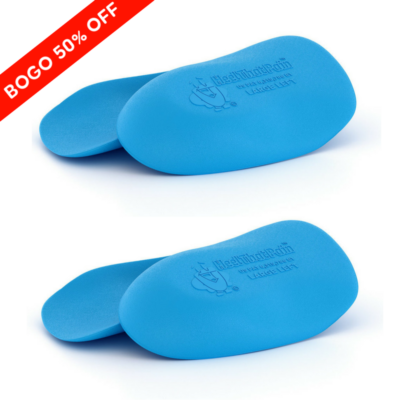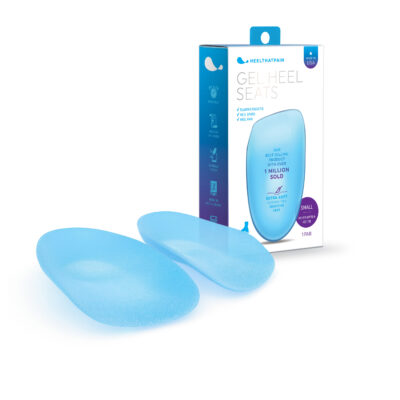Heel Pain during Gymnastics
While it’s impossible to say which muscle group or body part is most critical to the sport of gymnastics, it’s safe to say that the feet land near the top of the list.
Unfortunately, heel pain from plantar fasciitis is common among gymnasts and can make it very difficult to stick a landing, run, or even walk without severe heel pain.
If you or a loved one tumble, it’s important to know the warning signs, risk factors, and steps to treat plantar fasciitis before it interferes with the sport you love.
Can You Get Plantar Fasciitis from Gymnastics?
The short answer is yes. Heel pain from plantar fasciitis is very common among high-impact sports like tumbling or gymnastics that place a lot of strain and impact on the plantar fascia ligament, which runs along the bottom of the foot.
Plantar fasciitis is especially common in gymnastics because the sport must be done barefoot, without the support of shoes that help distribute and absorb the impact from jumping or running.
Heavy practice weeks, injuries that destabilize the foot and surrounding muscle groups, gymnastics routines that involve a lot of heavy impact or jumps and sudden movements can take a heavy toll on the plantar fascia. The fascia may flatten, making it difficult to absorb impact properly. And as damage compounds, the fascia may sustain small tears and micro-injuries that lead to pain and inflammation as it begins to deteriorate.
Risk Factors for Gymnastics and Foot Pain
Gymnasts are at particular risk for developing heel pain for a few different reasons. Understanding these risk factors can help you plan plenty of rest and foot care into days and weeks that include activities that place particular strain on the plantar fascia:
- Injuries to the feet or legs during practice or meets can lead to plantar fasciitis, even if the injury wasn’t directly to the foot or fascia. Injuries to the feet, legs, hips, knees, or ankles can cause biomechanical imbalances that change the gait put extra strain on the plantar fascia. Injuries can also lead to decreased flexibility and muscle strength in the muscle groups and ligaments that support the plantar fascia.
- Repetitive movements (especially high impact jumps and landings) can lead to flattening and small tears in the plantar fascia. This repetitive impact can also cause the heel’s protective fatty pad to wear and grow thin, leading to increasing heel pain and sensitivity.
- Because most tumbling and gymnastics routines are done barefoot, the arch can’t rely on any extra support from shoes. This means that the arch alone is left to absorb the impact of any high-impact landings, jumps, or running.
- During intense periods of preparation for a meet, the arch may not be able to repair damage and rest properly, leading to compounding injuries and severe strain.
- Since gymnastics is most often a sport performed by young people, it’s possible that the heel pain is not plantar fasciitis at all, but Sever’s disease (read more on that next!)
It’s important to pay attention to these risk factors, and stay alert to any pain that may develop in your heels or feet after a meet or practice. Preventative care, combined with addressing warning signs of heel pain early can avoid setbacks and long recoveries (like some of the famous gymnasts below!).
Could Your Gymnast’s Heel Pain Be Sever’s Disease?
Sever’s Disease is a common condition in children ages 8-15 that, like plantar fasciitis, causes heel pain and discomfort while walking or standing.
Unlike plantar fasciitis, which is caused by strain and deterioration of the plantar fascia, Sever’s Disease develops when the heel bone (one of the first bones to reach full size) develops faster than the surrounding ligaments and muscles, making it more vulnerable to injury and trauma from high-impact activities (like gymnastics!)
If a gymnast complains of heel pain, redness or swelling in the feet, and has difficulty walking or standing, it’s important to rule out Sever’s disease with a doctor as quickly as possible, since ignoring this serious condition can have a long-lasting impact on a child’s growth and development.
Learn more about Sever’s Disease
Warning Signs of Heel Pain Associated with Tumbling
Heel pain in gymnasts may come on suddenly after an injury or gradually and sporadically. Because heel pain often develops gradually, it can be easy to ignore the warning signs of plantar fasciitis until significant damage to the fascia has taken place.
Pay attention to the following warning signs, and take steps to treat your feet with care (up next!)
- Redness or swelling along the bottom of your foot
- Painful heels (especially first thing in the morning, when the plantar fascia is stiff and tight after a night of inactivity).
- Pain that intensifies when you flex your toes upward and tense your foot (dorsiflexion)
- Pain that is dull, aching, or sharp
- Pain that gets worse after heavy practice sessions or long periods of time on your feet
Foot Care Tips for Gymnasts with Sore Heels
Proper foot care that protects your arch can help avoid plantar fasciitis, as well as treating heel pain symptoms if they do arise. Most cases of plantar fasciitis (about 90% can be treated easily and effectively at home). By catching the problem early, you have the best chance of a quick recovery without too much downtime from the sport you love:
Tape Your Feet
While your feet do need to stay bare for gymnastics, taping offers some of the support of shoes with none of the restriction. Use KT tape (which can stay in place for several days at a time) to protect and support your arch and foot, as well as improving blood flow and circulation.
Wear Specialized Shoes When Possible
While gymnasts may not be able to wear most shoes, they can take advantage of the specific shoes made for certain events. For example, apparatus shoes may be used when a gymnast performs a dismount. Vault shoes with padded soles may be used when a gymnast performs a vault to help absorb the shock of a hard landing. This can effectively minimize heel pain.
Use RICE When Heel Pain Strikes
RICE treatment (short for rest, icing, compression, and elevation) can reduce swelling and redness after an intense practice or workout. RICE lowers inflammation, improves circulation, and helps the plantar fascia heal from micro-injuries. If you’re experiencing heel pain, stay consistent with RICE pain until symptoms subside.
Learn more about RICE treatment
Try Barefoot Wraps
When taping isn’t possible or ideal, barefoot wraps can offer arch support with a barefoot feel, keeping your toes and the majority of your foot free while re-aligning and supporting the arch. Barefoot wraps can help significantly with heel pain as well.
Read more about barefoot wraps
Wear Supportive Shoes with Orthotic Inserts After Practice
If you’re experiencing heel pain caused by gymnastics, it’s important to take a holistic approach in supporting your arch during and after practice. While it might not be possible to wear shoes during practice, you can wear properly fitting, supportive shoes after practice with orthotic inserts that support the arch and apply soothing acupressure to painful spots. Avoid going barefoot when possible outside of practices and meets, and steer clear of nonsupportive shoes like slippers and flip flops.
Read more about orthotic inserts
Stretch and Strengthen the Fascia
If you’re a gymnast, there’s no doubt that you’re strong! Make sure your feet, toes, and ankles can keep up with the rest of you in terms of strength and flexibility by doing regular stretches to strengthen the plantar fascia and surrounding muscles. Stiff, weak muscles and ligaments are easy to injure, while strong, flexible muscles and ligaments resist injury.
Rest
If heel pain gets unmanageable, gymnasts may need to stay off their feet for a few days. While that might sound impossible or inconvenient given your goals or practice schedule, remember that by taking your heel pain seriously and treating it properly, you can avoid much longer time off or more serious setbacks.
Keep in touch with your doctor while you work through symptoms of heel pain or plantar fasciitis. Each person, and each case of plantar fasciitis is unique, and your doctor will be able to help you on your path back to full health.
Famous Gymnasts with Plantar Fasciitis
Junior gymnast Jade Degouveia, whose team has been described by many as one of the very best in the history of gymnastics, helped the Sooners earn a third national title with her incredible floor and vault work. However, one day before her team left to compete at a road meet in Florida, Degouveia tore her plantar fascia (while some plantar fascia tears come on suddenly, many are the result of the untreated, progressive wear and tear of plantar fasciitis).
Likewise, Oklahoma gymnast Maggie Nichols struggled with heel pain and was sidelined for several months after a torn plantar fascia. However, with dedicated care and treatment for her plantar injury, Maggie went on to become the first woman to win the title of NCAA all-around champion twice in twelve years.
While most gymnasts won’t make the news with their heel pain or plantar fasciitis, their healing is no less important to staying in the game for this competitive and awe-inspiring sport. Watch for the signs of plantar fasciitis or Sever’s Disease, stay on top of foot care and preventative treatments, and stick those landings!







